Amol Palekar’s Paheli is based on a short story called Duvidha written by Vijayadan Detha. It has also been made into a film earlier by Mani Kaul. It is a story set in the deserts of Rajasthan. Lachchi (Rani Mukerji) gets married to Kisanlal (Shah Rukh Khan). Kisanlal is mousy, and is afraid to speak his mind in front of his domineering father. On the first night after his wedding, Kisanlal does not consummate the marriage, and tells Lachchi that he is leaving for pardes for five years. Lachchi, who had been looking forward to a blissful married life, is heartbroken when she gets to know this. However, after he leaves, a shape-shifting ghost, who had been mesmerized by Lachchi’s beauty, comes and takes the appearance of Kisanlal. Everyone thinks that Kisanlal has come back, but in reality, it is only a ghost. The ghost does not lie, and tells Lachchi that he is not her husband, but is a ghost who has only taken the form of her husband, and she can ask him to leave if she does not want him to stay in her life. The film’s title is apparently a reflection of this paheli, though the word duvidha is more befitting as it means dilemma, while the word paheli means a riddle. Lachchi does not take much time to resolve this duvidha, and she readily accepts the ghost because, in her life, no one ever asked her wish, and here is a ghost who will only stay if she wants him to be. The one who took marriage vows to stay with her for seven ages did not stay with her even for seven days, so she chooses the ghost. Lachchi and the ghost Kisanlal lead a happy life, without thinking of their future. But, eventually, the future becomes the present in a few years, and the real Kisanlal returns, leading to another paheli where Kisanlal’s family members and the villagers have to decide as to who is the real Kisanlal. A gadariya (Amitabh Bachchan) solves this paheli to identify Kisanlal, leading to some interesting turn of events in the end.


There is a lot to love in Paheli. The women in the film support each other, while the men try to put other men down. All through the film, the women in Lachchi’s family are supportive of her, be it her friends, her sister-in-law, or her mother-in-law. When they find out that a ghost had fathered her child, they do not disown or ridicule her as is, generally, seen in such stories. Instead, they console her by saying that if they could not identify their own son, how can they expect that she would know that it is a ghost. In the beginning moments of the film, Lachchi’s friends are teasing her about her first night after the wedding. They sing to her to not give in to her husband’s advances, but she tells them, “Jagne ki raat ayi hai, dekha karati thi sapana, sapane ko akhir apana, kehne ki raat aayi hai.” She had dreamed of this night since long, and now, her dream is becoming a reality. That a bride, who is traditionally portrayed as demure and coy, is not shy to celebrate the upcoming consummating of her marriage is something that even films set in the contemporary era are hesitant to portray. The women want to enjoy life, like Lachchi wants to eat a bunch of ber, while the men try to suppress their own desires, and run away. It is Lachchi who tells her husband to take her veil off on the wedding night, and she is the one who wants Kisanlal to make love to her, while he runs away saying that it is not a good idea to ignite the passion for a single night. Kisanlal goes away the next day, not able to say no to his father. Likewise, Kisanlal’s father’s brother runs away when he lost a camel race, while his wife carries on with her life with strength, certainly, much more than her husband. The women even portray their anger in their own ways when the men do things they don’t like, like Lachchi expresses her unhappiness by banging the plate when the ghost helps their family win a race through some tricks. In 2010, a gem of a film called Mirch, was released and, then, quickly forgotten. The screenplay involved three short stories, each set in ancient, medieval, and modern times. One story was based on a queen, played by Konkona Sen Sharma, who is married to a much older king, played by Prem Chopra. In order to get her sexual desires fulfilled, the queen dupes the king in a ridiculously hilarious fashion, and makes love to another man in front of her husband. The other stories in Mirch had similar sexual themes of female desire. Sometimes, it makes me feel that over the years, if our films have become more conservative. Stories set in ancient times were liberal in their portrayal than those set in today’s time. Notably, there is another Rani film, and one of my favorite films, Aiyyaa, that talked about female desire and female gaze. Likewise, Paheli, too, is an important film in this regard that treats its women much ahead than time.

At one point in the film, when the ghost and Lachchi make love, it rains heavily, and then, a glorious rainbow appears. It is as if the parched desires of Lachchi have been fulfilled. Was the rain only in Lachchi’s mind because Kisanlal’s uncle wonders why there was such a noise and the ghost replies that it was the rain? The uncle wonders whether it really rained in the desert or was it the effect of hallucinations of chillum. In one or two more such instances, the film makes us wonder if there is some another paheli that we need to figure out on our own.

At another point in the film, Kisanlal asks the ghost about his real identity. The ghost replies, “Aurat ke dil me jo preet hove, vo hu main.” He is the yearning that resides in a woman’s heart. In the end, the ghost is trapped in the bag by the gadariya, but he manages to escape. In the original story Duvidha, the ghost is captured in the bag, and is thrown away. The ghost is a metaphor for the woman’s heart. In Duvidha, the woman goes back to her husband, and her wishes have been suppressed, but Paheli, changes that end, and again makes the larger point of women having the ability to live with their desires. The ghost is an ideal ‘man’. He respects Lachchi’s wishes. He is madly in love with her. He never lies to her. He wants to help others. He helps build a well for the villagers (as Mohan Bhargava did in Swades). He feels things, and laughs uncontrollably when he is tickled. He wants a daughter, and not a son. He thinks from his heart. He is absolutely perfect, but he is not human. On the other hand, Kisanlal thinks more from his mind, and suppresses his desires. It is not that he does not love Lachchi, but he is unable to express his love to her. He even thinks twice before writing a letter to her. There is a Freudian element to Kisanlal and the ghost. Kisanlal has the mind, and the ghost has the heart. In some ways, both of them complete each other; hence, it is quite interesting that in the end, they merge to become one person. In Rab Ne Bana Di Jodi, Suri and Raj had similar personas like that of Kisanlal and the ghost. Early in the film, Kisanlal’s father tells Kisanlal that God is a businessman, like him. He keeps track of the breaths of living beings, the movement of the winds, and the count of stones on the earth. Kisanlal is always counting as a businessman. Even on his wedding night, he remembers that he forgot to add the expenses of coconut. Later, the puppets tell that even Gods have sinned in the past. Kisanlal himself is named after a God, thus, in the end, Kisanlal—the man—becomes a representation of God and the ghost. He acquires characteristics of both of them, and becomes a complete man.

The one other thing that constantly came to my mind while watching Paheli was that it is quite similar to a Sanjay Leela Bhansali film. Paheli released in 2005, and till then, Sanjay Leela Bhansali had made four films—Khamoshi, Hum Dil De Chuke Sanam, Devdas, and Black. However, some of the scenes in Paheli are reminiscent of Bhansali’s films after 2005. There are vivid colors, lovely mirror images, flowing fountains, sublime top-view shots, and beautiful peacocks everywhere in the background—all signature elements of a Bhansali film. However, the scale is not as grand as in a Bhansali film.

Mirrors

Peacocks
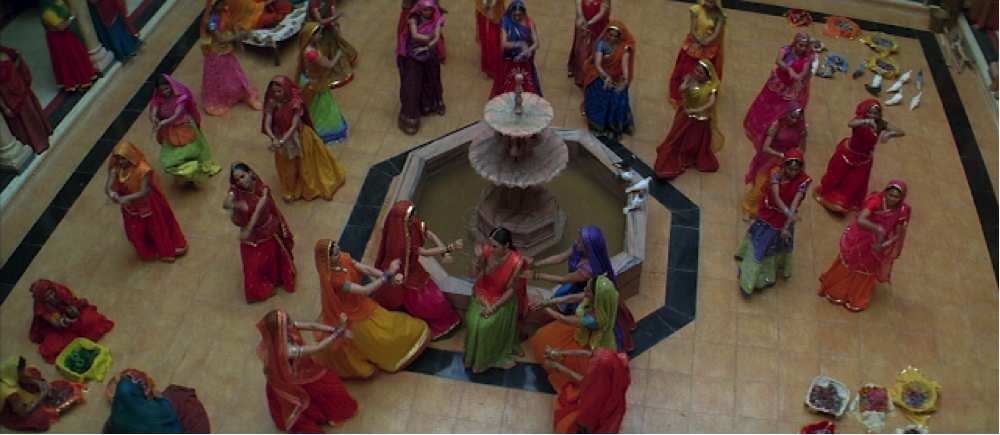
Fountains
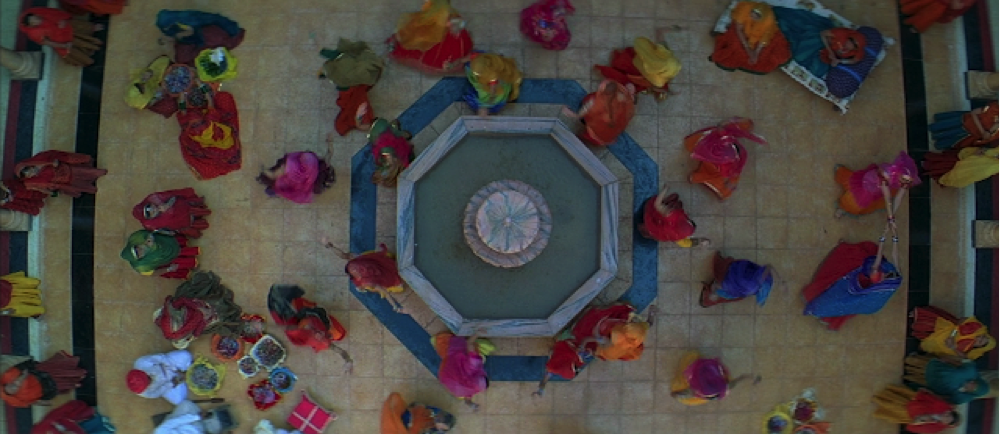
Top-view Shots
The puppets were fabulous as if giving action to the famous line from Anand, “Hum sab to rangmanch ki kathputliyan hain jiski dor us upar wale ke haathon main hai. Kab, kaun kahan uthega ye koi nahin jaanta.” Instead of humans depicting stories through puppets, we see puppets depicting through humans. Naseeruddin Shah and Ratna Pathak Shah voice the puppets, and bring a context to the proceedings as the sutradhaars. At an earlier point, the puppets say that, generally, a ghost enters a man, but it is the first time, when an insaan has entered into a ghost, referring that Lachchi has entered into the ghost’s mind. Traditionally, a ghost is portrayed as a blood-sucking demon, but this ghost is not a vampire, rather a Good Samaritan, and more importantly, has qualities even better than those of a human. The film never adheres to some of these clichés, and veers away from the stereotypes.
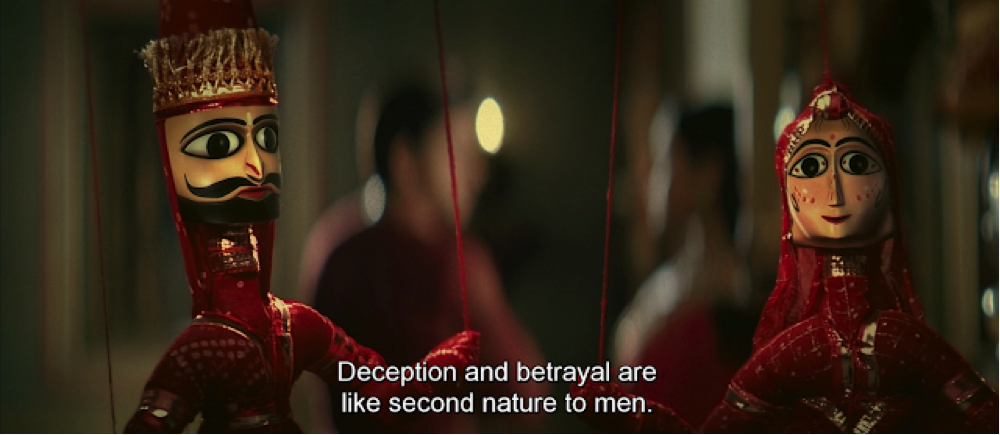
Rani as Lachchi is lovely. There are so many close-up shots of Rani’s eyes, and she conveys a lot through her kohl-lined eyes. Seeing any Rani film makes me realize how much I miss seeing her in films. Rani as Lachchi is another great role in her filmography. Lachchi makes us ask questions on the meaning of marriage. Is husband only a man with whom you take the seven vows, or is he a man with whom you share every detail of your life? Shah Rukh brings the contrast in Kisanlal and the ghost really well. There are clear differences in the personalities of Kisanlal and the ghost, and Shah Rukh executes them excellently. It is one of the classic romantic roles that he is known for. Juhi Chawla as Gajrobai delivers a fine performance in a short role. Though it felt odd to see Juhi, who has been paired opposite to Shah Rukh as a lead in many films, play a role quite elder to Shah Rukh. There is a lovely scene when she is breaking the cotton, and Lachchi comes and tells her to come to the temple, but she says how can she wish for someone to come back who has gone on his own volition. Juhi conveys the loneliness of a woman whose husband has run away beautifully. She also understands the pain of solitude when Lachchi’s husband leaves her the next day, and thus, forms a bond with their based on their shared loneliness. And, not to forget, Rajpal Yadav as Bhoja is terrific. He gets completely into the skin of the character.
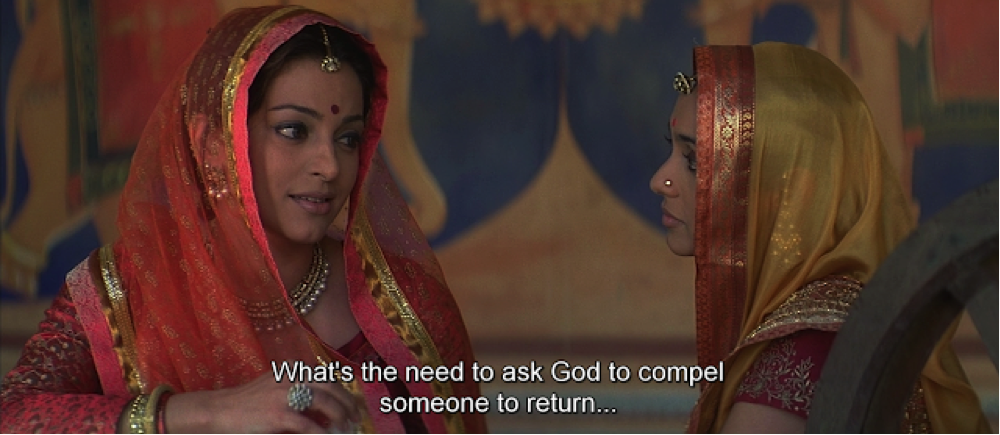
One of my favorite books, Cuckold by Kiran Nagarkar, is based on the story of Meerabai’s husband Maharaj Kumar, who is jealous of her wife’s love for the blue flutist Krishna. He wants his wife to love him, and not the Krishna. The dilemma is that if his wife’s paramour was a mortal, he could kill him. If he was a devil, he could exorcise her of one, but how does he fight a God. “You can exorcise the devil, but how do you rid yourself of a God.” At one point, Maharaj Kumar dresses up as the blue flutist Krishna in the hope of getting some love from his wife. He says, “To combat a God, one must become one, or at least masquerade as one.” This is what happens in Paheli. The ghost masquerades as the husband, and then, he actually, becomes the husband by merging with him. And, the interesting thing is that the protagonists, in Cuckold and Paheli, are a human and a supernatural being, and both of them are related to Krishna in some way. Perhaps, this is another paheli that we need to solve on the strange cosmic connections that never cease to amaze us.
[Read more of the author’s work on his blog here.]

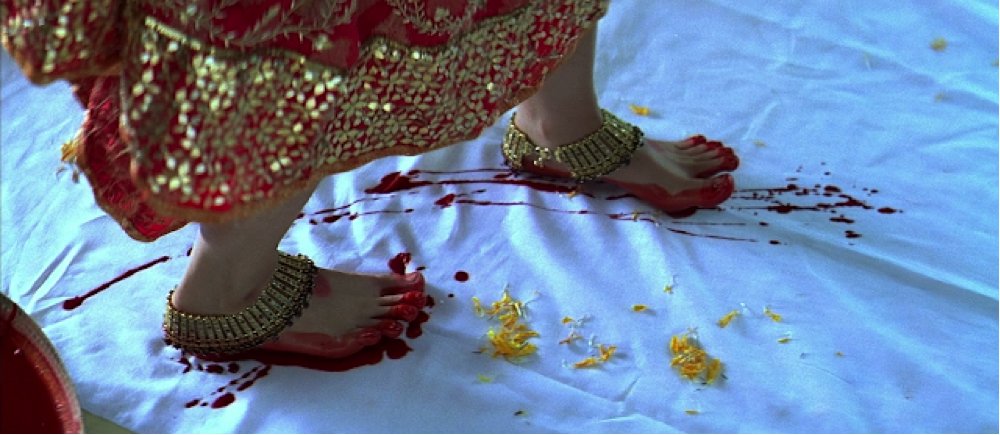




Leave A Comment
You must be logged in to post a comment.